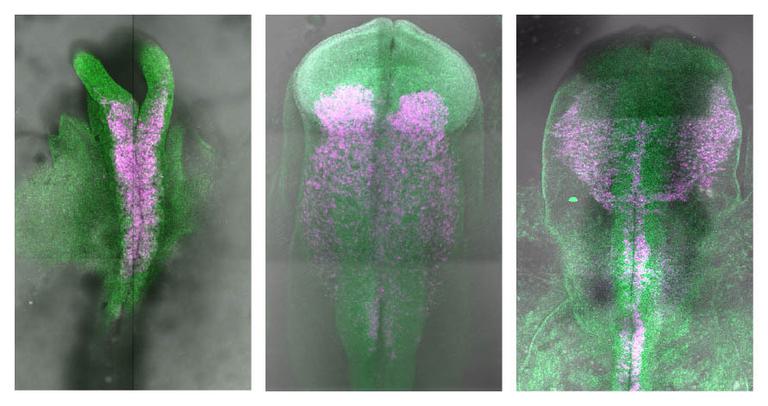News
15 April 2025
Light sheet microscopy: A decade-long journey from DIY innovation to cutting-edge imaging
A look at the technology that provides researchers with deeper insights into complex biological systems.
Read Article
News
Until now, scientists didn’t fully understand how Chd7, a gene that helps unpack tightly wrapped DNA, becomes activated within the neural crest during development.

Chd7 (green) and master regulator Sox10 (magenta) is expressed in neural crest cells and throughout the neural tube, as well as the surrounding tissues at chick developmental stages spanning the formation and initial migration of neural crest cells.
By Rachel Scanza, Ph.D.
CHARGE syndrome is a rare yet devastating congenital condition affecting tissues and organs such as the heart, nerves, genitals, eyes, and ears. Over 90% of cases arise from mutations in a single gene, Chd7, which is critical for the proper development of neural crest cells, versatile cells of the embryo that form diverse structures in the body. Until now, scientists didn’t fully understand how Chd7 becomes activated within the neural crest during development.
New research from the Stowers Institute for Medical Research has shown that Chd7 relies on specific regions in DNA, called enhancers, to “turn on” at the right time and in the right cells, including neural crest cells. Like genetic switches, these enhancers interact with special proteins to jumpstart Chd7 activity in specific tissues. The findings suggest that mutations in these neural crest-specific enhancers may contribute to cases of CHARGE syndrome without changes in the Chd7 gene itself, offering a potential path for further research and potential treatments.
“We wanted to know how and why Chd7 has elevated activity specifically in neural crest cells,” said Ruth Williams, Ph.D., a former researcher in the lab of Stowers Investigator Tatjana Sauka-Spengler, Ph.D., and now an MRC Career Development Fellow at the University of Manchester.
Williams, who led the recent study published on October 30, 2024, in PLOS Biology added, “For congenital conditions like CHARGE syndrome, which is caused by problems in neural crest development, finding the enhancers that boost gene activity could lead to new gene therapy options—especially when the exact cause of these conditions isn’t known.”
During development, genetic circuits determine how cells gain their functions. Starting from just a single cell, these circuits called gene regulatory networks control how and when various genes are turned on or off to provide proper instructions for every cell in the body. Special proteins govern these networks. This includes neural crest master regulators that specifically interact with enhancers to guide gene activity.
“We wanted to understand where Chd7 sits in the circuitry that specifies neural crest cell development and what is it driving or being driven by,” said Williams.
The discovery of the new enhancers was aided by two technologies, one that identifies regions of exposed DNA, and another that illustrates how the genome is organized in three dimensions. This allowed the team to “see” where and how different parts of the genome are communicating.

Localization of various Chd7 enhancer activities (green, EnhA-T) during cranial neural crest development in chick.
Chd7 is a type of gene that helps unpack tightly wrapped DNA, making it accessible so other genes can be read and activated. The team was surprised to find enhancers regulating Chd7 in neural crest cells, which was unexpected since enhancers typically don’t influence genes that control DNA access.
While Chd7 is broadly active in many tissues, its control in driving neural crest fates must be precise. The team found that the enhancers driving Chd7 were indeed specific to different tissues. Different enhancers govern the expression of the gene in neural crest cells, in the neural tube, and in the embryonic brain and spinal cord.
“By having multiple enhancers driving Chd7 activity, cells ensure precise function across different tissues,” said Williams. “Neural crest cells need more Chd7, and this distribution minimizes the impact on development if one enhancer malfunctions.”
Counterparts of chick Chd7 enhancers were also identified in human genomic data, suggesting a highly conserved neural crest regulatory network and how animal systems can help gain insight into human diseases. The Sauka-Spengler Lab and the newly established Williams Lab study neural crest formation, cell fate, and the regenerative capacity of these cells that link them to several cancers. Many congenital conditions arise from defects in the neural crest, highlighting the potential impact both labs’ research may provide for mitigating such conditions.
Additional authors include Guneş Taylor, Ph.D., Irving T. C. Ling, M.D., Ph.D., Ivan Candido-Ferreira, Ph.D., Daniel Fountain, Ph.D., Sarah Mayes, Perihan Seda Ateş-Kalkan, Ph.D., Julianna Haug, Andrew Price, Sean McKinney, Ph.D., Yavor Bozhilovh, Ph.D., Richard Tyser, Ph.D., Shankar Srinivas, Ph.D., and Jim Hughes, Ph.D.
This work was funded by the Wellcome Trust (award: 215615/Z/19/Z) and institutional support from the Stowers Institute for Medical Research.
News
15 April 2025
A look at the technology that provides researchers with deeper insights into complex biological systems.
Read Article
News
11 April 2025
“There are few rewards as powerful and as elevating as making a clear, robust scientific observation that advances the field.”
Read Article
News

09 April 2025
New study shows how we can better learn our genome’s hidden grammar, potentially paving the way for personalized medicine.
Read Article
